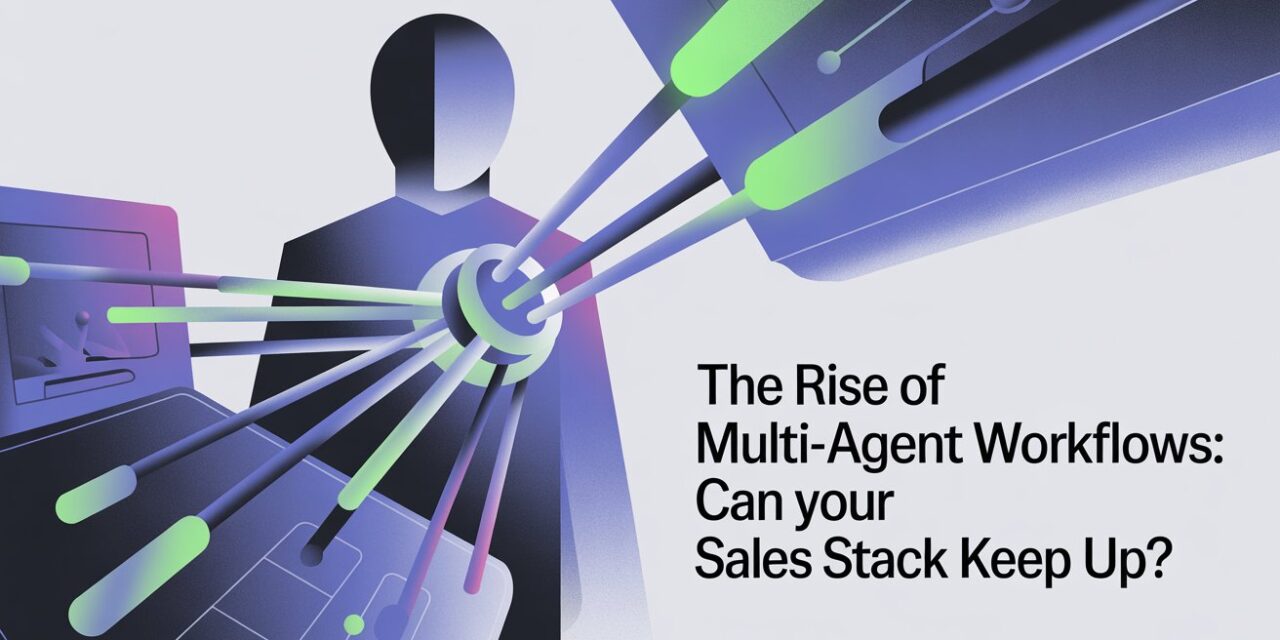
The Rise of Multi-Agent Workflows: Can Your Sales Stack Keep Up?

AI is moving faster than your sales stack. That’s not a hot take—it’s a fact.
Right now, most teams are busy trying to plug GPT into emails or automate call notes, while the real wave has already begun: multi-agent workflows. Not one AI doing one task. But multiple specialized agents collaborating autonomously across functions—prospecting, outreach, research, follow-ups, scheduling, even pipeline updates—all without human intervention.
This is not just automation 2.0. This is orchestration.
And most sales stacks are woefully unprepared for it.
OpenAI below shows their thoughts on what is to come, putting things into 5 levels. As a whole, most people that I am seeing are just barely using Reasoner models with o1 and o3 GPT models or a deep research tool.
But the capabilities are deep into Level 3 and going into Level 4.

What Are Multi-Agent Workflows, Really?
Let’s clear the hype. A multi-agent AI workflow isn’t just running ChatGPT three times in a row with different prompts. These are coordinated, intelligent agents—each trained for a specific sub-task—communicating, adapting, and executing in sequence (or in parallel), often without needing a human in the loop until the final output. Think of it as:
-
One agent doing deep account research
-
Another writing a personalized intro email
-
A third timing and sending it
-
A fourth listening for replies, parsing objections
-
A fifth updating your CRM or triggering a Slack ping with a suggested next move
Now multiply that across dozens of leads, simultaneously.
Now imagine it’s happening while your team is asleep.
Welcome to the new normal.
Here below is an idea of taking 1 simple task of qualifying a sales lead where we show 4 versions.
1-Human led old school, no AI
2-Human led AI old school as I call it, which is prompting based, but relies on the human to drive it
3-Where Agent works through the entire process and proactively feeds info to the human
4-Every step has multi agents so for example in step one of research, you have an AI Agent for financial research and is specialized in 10ks and the overall market, another AI Agent that goes deep into Linkedin, articles etc, another one that knows your tech and the pains of your ICP and so on.
Most people are still prompting (not very well) and do not know what is coming and what is available. And sadly, the biggest thing holding people back is not their capability or willingness, its the company being willing to give them the time, tools, and know how to execute.

Why It Breaks Most Sales Stacks
Most CRMs and sales engagement tools were built for linear workflows—open tab, input data, push sequence, wait. They were never designed to support multi-agent ecosystems where tasks are generated, executed, and adjusted based on real-time decisions across several tools.
What I am beginning to call, “old school tech” has an old philosophy, which is “to prove value we need humans to adopt the platform”
So what happens when you have tons of tools that all want you to adopt the platform? The poor front line team has a bajillion tabs open for every task they have to accomplish and cannot get anything done.
Salesloft for sequencing, Gong for calls, Zoominfo for data, Google stack for decks and content, Highspot for content and bla bla bla bla.
Here’s where they fail:
-
No native agent communication layer: Multi-agent systems need persistent memory and shared context. Your CRM doesn’t support that.
-
APIs not built for autonomy: Most tools require structured inputs, but agents operate best in semi-structured or inferred environments.
-
No agent-to-human UX: CRMs are built for humans. But what happens when your buyer is being engaged by a team of agents before the rep ever gets involved?
-
Signal overload with no prioritization: When agents run asynchronously, they generate more data—more signals. Without a system to prioritize and summarize them, it leads to chaos.
Put simply: your current stack wasn’t built for autonomous collaboration between intelligent systems. And no, that Salesforce plugin won’t fix it.
If you want to enter the new world of AI Agents and using teams of them, you have to leave behind the thinking of old technology.
The Best AI tools I have seen in action, are the ones that GO TO THE HUMAN instead of the human going to it.
AI can act in context, at the right time, providing the right content, action, insight, or data when its needed and allow the human to do what we are supposed to be doing in the first place which is…
Talking to other humans aka customers.
Examples of Multi-Agent Workflows in Action
This isn’t science fiction—it’s already live.
-
Outbound SDR Replacement: One agent pulls new ICP accounts from Crunchbase, another cross-checks signals from LinkedIn + website traffic, a third drafts and sends hyper-personalized messages, and a fourth handles the objection if they reply “Not now.”
-
Demo Flow Orchestration: One agent coordinates the invite. Another preps the AE with competitive battlecards. A third transcribes and scores the call. A fourth sends follow-up and fills CRM fields. None of these are your team.
-
Live Pipeline Management: One agent monitors stuck deals. Another triggers nudges to the rep. A third generates insights to revive interest or push for a timeline.
Startups like Bardeen, AutoGen, Tavily, MindStudio, CrewAI, MultiOn, and LangChain are already enabling these flows behind the scenes. They’re not selling into your RevOps team yet, but they will be. The question is: will you be ready?

What AI-Native Actually Means
Everyone says they’re “AI-powered.” That’s not enough.
To be AI-native, your stack needs to meet three core criteria:
-
Agent-First Design: Your system should support autonomous workflows across roles, tools, and time zones—without constant human triggers.
-
Structured + Unstructured Context Handling: Agents need access to raw call transcripts, emails, notes, and summaries—and the ability to reason through them.
-
Composable Intelligence: Your stack should allow agents to plug into workflows modularly (e.g., swap a research agent with a better one) without breaking the entire system.
Most tools claiming “AI” are still just building wrappers around GPT or embedding chat assistants. That’s not orchestration. That’s duct tape.
Leaders: The Time to Evaluate is Now
If you’re a CRO, RevOps leader, or founder reading this, ask yourself:
-
Can my stack support multiple autonomous workflows happening simultaneously?
-
Do we have agent-based alerts, triage, and decision systems—or are we just logging tasks?
-
Is my enablement function preparing reps to work with agents as peers in execution?
-
Have we designed rules of engagement for when a rep steps in, and when the agents handle it?
This is no longer a future conversation. The companies that are testing this now will widen the gap quickly. They’ll out-hustle, out-learn, and out-close those who are still trying to train reps to remember to log call notes manually.
Building for the Multi-Agent Future (Without Breaking Everything)
So you’re bought in. You see the future: AI agents coordinating across your revenue team, executing tasks faster than humans, handing off seamlessly, scaling execution like never before. It’s compelling—and it’s happening.
But before you spin up your own GPT-powered SDR army, it’s time for a reality check. Building multi-agent workflows is not just about automation—it’s about alignment, security, and data structure. And this is where most teams hit a wall.
The Hidden Complexity of Multi-Agent Systems
While platforms like AutoGen, CrewAI, and LangChain Agents are pushing boundaries with multi-agent orchestration frameworks, they introduce challenges most revenue leaders haven’t had to think about:
-
Security: Agents operating across tools need access to emails, CRMs, call logs, and cloud storage. That’s a lot of surface area. If you don’t control the identity and data scope of each agent, you’re setting yourself up for compliance headaches or worse.
-
Compliance: If agents are touching PII, regulated industry data (HIPAA, GDPR, SOC 2, etc.), or customer communication threads, you must be sure that the system adheres to your legal and privacy obligations. Most open-source or plug-and-play agent systems aren’t ready for that.
-
Orchestration logic: Building workflows where agents reason about next steps, coordinate with other agents, and escalate correctly is complex. It’s not just “build once, run forever.” It requires context management, state persistence, and fallback paths.
-
Data quality: Agents are only as good as the data they’re trained on or given access to. If your CRM is full of garbage or missing context, your agents will act on garbage logic.
Why First-Party Context is the Game-Changer
This is where most DIY agent stacks fail. They lack high-fidelity, first-party data to act on. The real key to agent intelligence isn’t just the LLM—it’s the structured, contextual, reliable data it can access.
That’s why tools like Momentum.io are critical. Momentum isn’t only an AI agent provider. Instead, it acts as the first-party data orchestration layer, collecting clean, real-time context from the places reps actually work—calls, emails, Slack, support tickets, and SMS threads. Then it automatically populates your Salesforce fields with that structured insight.
You don’t have to worry about reps logging notes. You don’t have to chase updates. You don’t have to duct-tape five APIs to trigger a Slack notification. Momentum makes sure the right data is in the right field at the right time—without lifting a finger.
(I am the Head of Growth for Momentum, so you know I had to put a plug in for my team 😉
Why That Matters for Your Agents
Once your fields are clean, consistent, and reflective of reality, then your agents can fly:
-
Your forecasting agents can pull from actual buyer signals—not “stage = proposal” noise.
-
Your CS handoff agents can trigger instantly when a deal closes, based on accurate, structured data.
-
Your objection-handling agents can look at previous conversations tagged with “pricing delay” and auto-suggest rebuttals.
-
Your QBR prep agents can generate summaries based on real data, not email archaeology.
Your CRM with clean reliable data (who would have thought right?) becomes the connective tissue that feeds agents across your stack with the context they need to make smart, timely decisions—without requiring you to rebuild your entire infrastructure from scratch.
Agent-Ready ≠ Agent-Native
A lot of tools will claim they’re “agent-ready.” What that really means is they’ve bolted on a GPT plugin or added a chat assistant. But if you want agent-native execution, you need three things:
-
Real-time access to structured first-party GTM data
-
Infrastructure for triggering and orchestrating agent logic
-
Guardrails for security, privacy, and compliance across workflows
Trying to stitch this together yourself is risky and expensive. But combining a platform like Momentum (for real-time GTM data and execution) with modern multi-agent orchestrators gives you both control and flexibility.
Bottom Line: Orchestrate AI, Don’t Just Deploy It
Multi-agent workflows are more than a technical shift—they’re a cultural one. It’s not just about layering on AI to do more work faster. It’s about giving your teams the ability to build, delegate, and coordinate like never before—with AI agents that operate not as tools, but as teammates.
But here’s the mistake most companies will make: they’ll try to control it from the top-down only.
They’ll centralize, restrict, and gate access until AI becomes another bottleneck—another innovation lost in procurement purgatory.
The smarter companies?
They’ll do both.
They’ll set the strategic direction from the top: What should be automated? Where do we want AI driving outcomes? What workflows are repeatable, scalable, and aligned to revenue and customer value?
And they’ll also empower their teams from the bottom-up:
They’ll let RevOps build agents that clean CRM data daily.
They’ll let AEs automate follow-up sequences with built-in deal context.
They’ll let BDRs spin up mini-agent chains that research, personalize, and send outreach while they sleep.
Because here’s the truth: when you hold your people back from building with AI, you’re holding your company back from winning with AI.
Companies who understand and empower their teams with AI, will use the unique human power that is amplified and your humans will become your moat like I spoke about before.
Where to Start: Actionable Steps to Enter the Multi-Agent Era
-
Audit Your Manual Repetition
Don’t start with what you can automate. Start with what you repeat constantly.-
Where is your team duplicating work?
-
Where are they following a playbook you could codify into an agent system?
Map those out. That’s your low-hanging fruit for AI orchestration.
-
-
Create a Top-Down AI Strategy Charter
Define which outcomes matter most—faster pipeline velocity, cleaner handoffs, higher renewal rates—and prioritize AI projects around those.-
Appoint a cross-functional AI council (Sales, RevOps, Enablement, CS) to evaluate impact and risk.
-
Set principles: where agents should act independently, where humans intervene, and where AI augments.
-
-
Enable Bottom-Up Agent Creation
Pick a group of forward-thinking reps, ops professionals, or CS managers.
Give them access to low-code/no-code agent-building tools.
Challenge them to build one workflow each in 30 days.
You’ll create internal champions, generate real use cases, and uncover insights your leadership team might miss entirely. -
Define the Guardrails, Not Walls
You don’t need to restrict every use. You need to shape it.-
What data can agents touch?
-
Who can trigger external communication?
-
When should a human approve an action before it goes live?
Enable freedom within structure. Innovation thrives when trust and clarity coexist.
-
-
Treat AI Agents Like Team Members
Just like you’d onboard a new hire, you need to:-
Assign owners for each agent workflow
-
Monitor performance, errors, and feedback loops
-
Set KPIs and review performance in your team’s operational cadence
-
Agents aren’t just “running in the background.” They’re executing in your frontline workflows. Treat them like part of the team.
-
Educate Through Use, Not Training
Don’t send your team to a 4-hour workshop.
Give them a starter pack:-
A prompt template
-
A short demo
-
A Slack channel to share what they built this week
Adoption comes from action, not theory.
-
Mindset Shift: Decentralized AI = Accelerated Revenue
This is the real unlock.
The companies that accelerate with AI will have two things in common:
-
A clear top-down vision of what to automate, why it matters, and how it supports revenue
-
A bottoms-up culture where everyone—from the SDR to the CSM—can build, experiment, and scale AI workflows that improve their day-to-day
If you only do the former, you’ll move slow and stay rigid.
If you only do the latter, you’ll move fast but spin in circles.
Do both, and you’ll create an AI-powered organization that learns, adapts, and scales faster than the market.
The companies that win in the multi-agent era won’t just be those with the most data.
They’ll be the ones who trusted their people with the power to build—and gave them the systems to do it right.
































